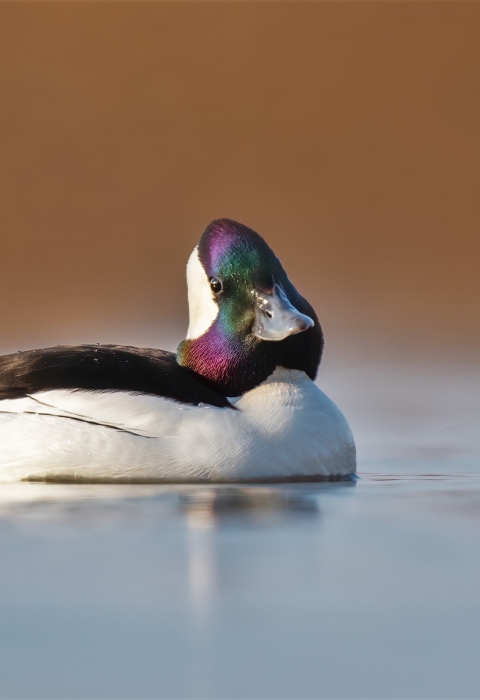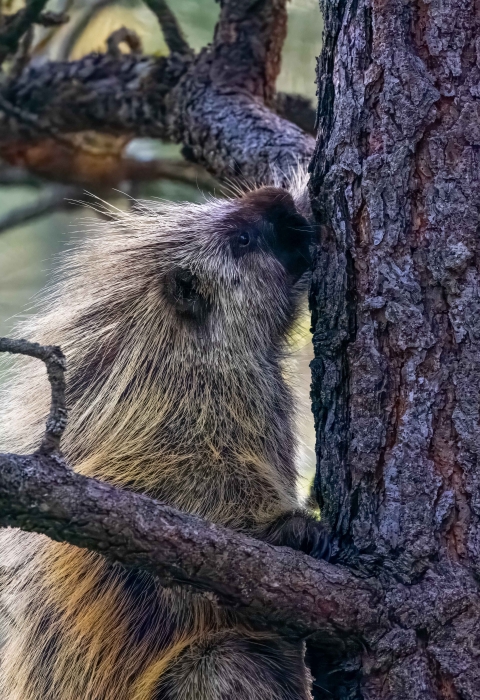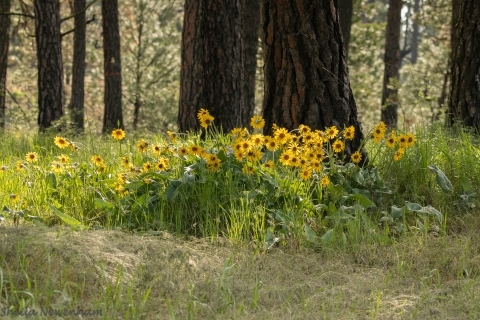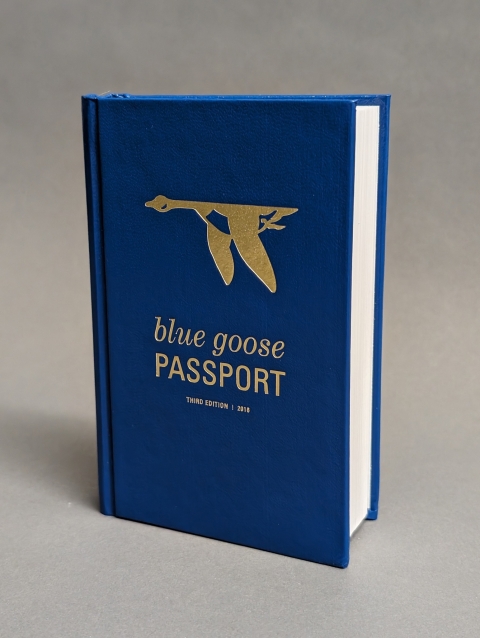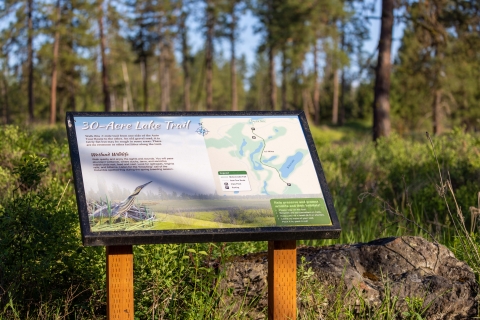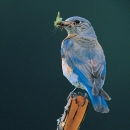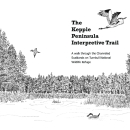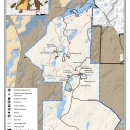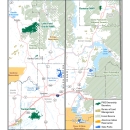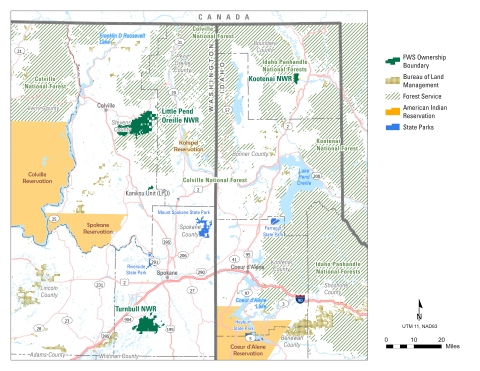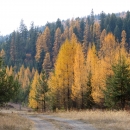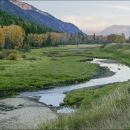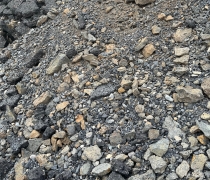
Turnbull NWR is hosting a small lot sale of approximately 300 yards of mixed gravel and crushed asphalt from a former building foundation demolished in 2023. Full details can be found online.
Visit Us
National wildlife refuges offer us all a chance to unplug from the stresses of daily life and reconnect with our natural surroundings.
At Turnbull National Wildlife Refuge, numerous forms of outdoor recreation are available. Whether hiking, bicycling, or driving, the refuge provides opportunity viewing the unique geology and diverse wildlife. Regulation of recreation activities allow for public enjoyment of the refuge while still protecting the wildlife and habitats. Visitor access is limited to a 3,300-acre Public Use Area, Columbia Plateau Trail and designated sites identified in hunt permits. The remaining portions of the Refuge are preserved as a wildlife sanctuary, with disturbance even by refuge staff kept to a minimum. Wildlife observation and photography are encouraged. You will find excellent wildlife viewing opportunities in the Public Use Area with its several trails that loop through wetlands, grasslands, pine forest and riparian riparian
Definition of riparian habitat or riparian areas.
Learn more about riparian habitats. Visitors are welcome to drive, walk or bicycle the 5.5-mile auto tour route where most waterfowl and other wildlife can be observed. Moose, deer, and elk are often observed during the early morning or evening hours which is the best time for viewing wildlife. In addition to the 44 mammal species and over 200 bird species, the refuge offers a plethora of wildflowers that peak in mid-May. Arrowleaf balsamroot, camas, prairie star, and lomatium are just a few examples of the beautiful flora found on Turnbull.
Visitor Contact Station
Let our staff and volunteers help you plan your visit! This is a great starting point for visitors to become more familiar with the refuge and the wildlife that live here. A general refuge brochure and hunting brochures are available at the visitor contact station, located inside the refuge headquarters building. While there, visitors can find more information on the refuge’s history, wildlife, and management. The Friends of Turnbull operate a small nature store in the visitor contact station which offers a wide variety of books, t-shirts, and other educational items. Note, the nature store is closed during the winter months from October 31 through March 31. Several trails begin just outside the visitor contact station, including the Pine Lakes, Headquarters, and Stubblefield Trails.
Activities
Things to Do
If you have 15-minutes...
- Stop by the visitor contact station for some information followed by a quick walk on the Headquarters Trail.
If you have one hour...
- Go birding! Turnbull is one of the best spots in eastern Washington to see migratory birds, especially in Spring and Fall.
If you have half a day or more...
- Go for a drive on the scenic auto tour and explore additional trails.
Blue Goose Passport Stamp
Visitors to Turnbull NWR can collect their free Blue Goose Passport stamp. The passport books are available for purchase through the Friends of Turnbull nature store. Much like the National Park Service's Passport To Your National Parks program, the Blue Goose Passport allows visitors to collect ink stamps in a collectible book to commemorate each of their explorations. Stamps feature the Blue Goose logo designed by J.N "Ding" Darling, a cartoonist turned conservationist and first director of the National Wildlife Refuge System, as well as the date and location of the refuge.
Recreational Opportunities
With the passage of the National Wildlife Refuge System Improvement Act in 1997, six wildlife-dependent recreational activities are often managed on refuges as long as they are determined to be compatible, legitimate and appropriate public uses of the refuge. Hunting, fishing, wildlife observation, photography, environmental education, and interpretation are often referred to as the "big six". Turnbull offers five of the big six, including environmental education and interpretation programs, great wildlife viewing and photography opportunities, and limited annual hunts for elk, turkey, and waterfowl.
Trails
Turnbull NWR is an excellent place to visit for those looking to take a leisurely walk, enjoying a hike on one of the several miles of trails, engage in some birding, and bike or drive the scenic auto tour route. Accessible Trails include Pine Lake Loop Trail, Kepple Peninsula Interpretive Trail and Blackhorse Lake Boardwalk.
Restroom facilities can be found at the visitor contact station, across from the Pine Lake Loop trailhead, and along the auto tour route at the East and West Blackhorse trailheads.
Respect wildlife and their habitats by observing and obeying all refuge rules and policies. Do not feed or harass wildlife. If an animal changes its behavior, you’re too close and need to back away. Learn more about Wildlife Watching Etiquette.
For a full list of trails, please stop by the visitor contact station or explore the interactive map. Please remember that all visitors are required to stay on designated trails and roads March 1 through August 15 to reduce disturbance to wildlife and habitats.
Related Documents
Below are a collection of brochures and maps for your convenience.
Other Facilities in the Complex
Turnbull National Wildlife Refuge is managed as part of the Inland Northwest National Wildlife Refuge Complex. A National Wildlife Refuge Complex is an administrative grouping of two or more refuges, wildlife management areas or other refuge conservation areas that are primarily managed from a central office location. Refuges are grouped into a complex structure structure
Something temporarily or permanently constructed, built, or placed; and constructed of natural or manufactured parts including, but not limited to, a building, shed, cabin, porch, bridge, walkway, stair steps, sign, landing, platform, dock, rack, fence, telecommunication device, antennae, fish cleaning table, satellite dish/mount, or well head.
Learn more about structure because they occur in a similar ecological region, such as a watershed or specific habitat type, and have a related purpose and management needs. Typically, a project leader or complex manager oversees the general management of all refuges within the complex and refuge managers are responsible for operations at specific refuges. A complex often shares common work priorities and budgets. Shared supporting staff, composed of administrative, law enforcement, refuge manager, biological, fire, visitor services, and maintenance professionals, are centrally located and support all refuges within the complex.
Other lands in the Inland Northwest National Wildlife Refuge include: two National Wildlife Refuges, several subunits, and conservation easements in northeastern Washington and northern Idaho. Turnbull National Wildlife Refuge, located just outside Cheney, Washington, serves as the complex headquarters. Turnbull is a 2-3 hour drive from Little Pend Oreille and Kootenai Refuges, respectively.
Despite common management oversight, each of the three complex refuges is unique.
Turnbull NWR
Turnbull features over 130 wetlands, ponderosa pine forest, steppe grassland, aspen, and rock outcroppings set in a distinctive landscape that offers many possibilities for experiencing nature.
Location: Southwest of Spokane, in Spokane County, Washington in the “Channeled Scablands”
Purpose: “. . . as a refuge and breeding ground for migratory birds and other wildlife (EO 7681, July 30 1937) and “. . . for use as an inviolate sanctuary, or for any other management purpose, for migratory birds.”
Acreage: over 23,000 acres
Habitat: The Refuge supports an extensive complex of deep permanent sloughs, semi-permanent potholes and seasonal wetlands formed in the depressions left in a landscape scoured by Ice Age floods over fifteen thousand years ago. The uplands are a mixture of ponderosa pine, Palouse steppe, basalt outcrops and scattered aspen.
Public Use: Turnbull attracts an estimated 49,500 annual visitors to its 3,300-acre public use area. Wildlife observation is the primary use but hiking and bicycling on the auto tour are also popular. In 2010 Turnbull offered its first elk and youth waterfowl hunts.
Established: 1937
Little Pend Oreille NWR
Little Pend Oreille is a mountainous forested refuge with clear streams, scattered lakes, and diverse outdoor pursuits.
Location: In Stevens and Pend Oreille counties, Washington in an area dubbed the Forgotten Corner.
Purpose: “. . . as a refuge and breeding ground for migratory birds and other wildlife (EO May 1939) and “. . . for use as an inviolate sanctuary, or for any other management purpose, for migratory birds.”.
Acreage: 42,594
Habitat: Six forest types including ponderosa pine, Douglas fir, grand fir, cedar, western hemlock, subalpine fir as well as 60 miles of stream, lakes, and wetlands.
Public Use: Little Pend Oreille attracts about 60,000 visitors annually who hunt, fish, view and photograph wildlife, hike, mountain bike, camp, horseback ride, cross country ski and snowshoe.
Established: 1939
Kootenai NWR
Kootenai is a small gem of diverse wetland, cropland, and upland habitats and recreational opportunities.
Location: West of Bonners Ferry, Idaho in Boundary County’s scenic Kootenai River Valley
Purpose: “. . . as a refuge and breeding ground for migratory birds and other wildlife." (June 24, 1964 approved by MBCC Memorandum).
Acreage: 2,774 acres
Habitat: Provides diverse habitats including wetlands, forests, streams, and riparian riparian
Definition of riparian habitat or riparian areas.
Learn more about riparian areas as well as crops for foraging wildlife.
Public Use: Wildlife observation, wildlife photography, walking, bicycling, hunting, interpretation.
Established: 1964
Rules and Policies
Know Before You Go
There are many fun, interesting, and educational activities you can do on Turnbull. Keep in mind, if an activity is not wildlife related and doesn't help in the protection or understanding of wildlife or their habitat, there are probably refuge rules governing the activity. Please check with refuge management before participating in an activity that could harm the environment or yourself.
We have several rules and regulations in place to help with the protection of our wildlife and their habitats, as well as for the enjoyment of all visitors to the refuge. Turnbull National Wildlife Refuge is actively patrolled by Federal Wildlife Officers. All federal, state, and local laws and regulations are applicable on refuge system lands and waters.
Cell phone reception in the refuge is extremely limited. Don’t assume it will work! Make a safety plan before you go and always let someone know where you will be and when you plan to return.
Weather in the Inland Northwest can fluctuate suddenly. Temperatures may reach upward of 100°F (50°C) in the summer and can drop below freezing 32°F (10°C) in the fall and winter. Dress in layers to protect yourself from the sun. Thunderstorms can appear suddenly and produce lightning. Dense blankets of fog are common, particularly in the mornings and evenings of the winter months.
Turnbull NWR has an extraordinarily abundant population of wood ticks. Take precaution when hiking during the spring and summer, when ticks are most active. Wood ticks are known to carry diseases among dogs and humans, including Rocky Mountain spotted fever, tularemia (Rabbit Fever), and tick paralysis. Although Lyme disease is the most commonly-reported tick-borne disease in the United States, it is rare in Washington State.
Refuge phone number: (509) 235-4723
Emergency Phone Number: 911
Locations
Refuge Size
Turnbull National Wildlife Refuge is over 23,000 acres (as of 2020). Of this total, approximately 3,300 acres (roughly 7%) is open to the public as a designated public use area. Areas outside the public use area are closed to the public at all times unless otherwise specified. The refuge maintains an approved stewardship boundary and is approved by Congress to acquire up to 32,640 acres within this boundary from willing sellers. To date, approximately 66% of refuge lands were purchased with Migratory Bird Conservation Commission funds (Federal Duck Stamp monies).
To the Turnbull Visitor Contact Station (Refuge Headquarters)
Traveling from Spokane
Turnbull National Wildlife Refuge is an approximately 40-minute drive from Spokane, Washington. From Spokane, take I-90 west to the Cheney / Four Lakes Exit (exit 270). Travel west on Highway 904 for approximately 5 miles to the city of Cheney, home of the Eastern Washington University. When you arrive in Cheney continue west through 3 traffic lights. After you pass the third light proceed for one half mile to Cheney-Plaza Road. There, on your left you will see a brown and white sign that reads "Turnbull National Wildlife Refuge 4.5 miles." Turn left on to Cheney-Plaza Road and drive south for 4.5 miles until you see a large refuge entrance sign with a pair of redhead ducks. Turn left on South Smith Road. You will see a welcome sign and kiosk. Refuge headquarters is 2.5 miles down the road.
Traveling from I-90 Eastbound (Moses Lake, Ritzville, Sprague)
Take exit 257 (Tyler) onto WA-904 E towards Cheney for 10.4 miles. Turn right onto Cheney-Plaza Road and continue for 4.2 miles. Turn left on South Smith Road. You will see a welcome sign and kiosk. Refuge headquarters is 2.5 miles down the road.
Traveling from US-195 / SR-270 Northbound (Pullman, Colfax, Rosalia)
Take the exit towards Plaza (non-numbered) then turn right onto South Cheney-Plaza Road. Stay on South Cheney-Plaza Road for 12.6 miles. At the intersection, turn right to continue on South Cheney-Plaza Road for an additional 5.6 miles. Turn right on on South Smith Road. You will see a welcome sign and kiosk. Refuge headquarters is 2.5 miles down the road.
